
Are you struggling to boost your business ROI despite your best digital marketing efforts and excellent social media marketing strategies? Here’s the catch! Instead of focusing solely on the practices you’re already implementing, consider what you might be overlooking. Are you practising social listening? If you are, fantastic! If not, you could be missing out on a wealth of opportunities.
Social listening is a strategy that connects you more closely with your audience. It allows you to understand their pain points and gain valuable insights that can help you enhance your services. By leveraging this feedback, you can generate innovative ideas for improvement.
Let’s dive into the details.
So, what is social listening? To explain it technically, it is the process of keeping tabs on several social media platforms to effectively track your brand references, along with information on your rival brands and associated keywords. Social media listening lets you track what audiences say about your brand in real time.
Let’s explain the concept with a brief and interesting story from ancient times. Once upon a time, there was a renowned ruler in the Middle East known as the Abbasid Caliph Harun al-Rashid, who reigned during the Islamic Golden Age (786-809 CE). History tells us that he often ventured incognito, blending in with his citizens to grasp their problems firsthand.
He did this out of sincere concern for his people’s well-being, swiftly addressing their grievances once he became aware of them. The result? His people admired him, and he made his kingdom thrive during his period. Don’t you think this was a genius strategy?
Now, what if we told you Harun al-Rashid was essentially practising social listening way back then? Not only Harun, but many renowned rulers practiced this strategy often to improve their rule. If you are the ruler and your Kingdom is your brand, then social listening, or social media listening, is a process that can remarkably contribute to your brand’s growth.
It’s surprising to realize that while the phrase might be new, the concept is actually very old, with roots in ancient history.
Social listening can help you gain invaluable insights into customer sentiments regarding your product or services, the challenges surrounding them, and the kind of improvements they expect from you. This enables you to continuously improve your product or service according to the audience's needs.
Lately, this process has grown so popular that nearly 61% of companies currently employ a social listening mechanism to track mentions of keywords, as per social media today reports. The effectiveness of social listening can't be overstated, which is why it has gone beyond traditional social media platforms. This is because not all conversations happen publicly, and you cannot access them.
Therefore, Social listening tools (which we’ll discuss later) can also be used to monitor private forums and online communities, with proper authorization, to get a more nuanced understanding of audience sentiment; remember the ruler we talked about just now, who had to disguise himself to grasp the full scope of his citizen’s grievances!
Furthermore, apart from the audience’s mentions, social listening can also track mentions of your competitor brands, discussions around popular content, and analyzing the emotions surrounding subjects relevant to your business.
Insights on these can shape everything from marketing campaigns and product planning to customer service and assistance, thus guiding you to make more informed and data-backed choices that would ultimately boost your business's profitability and boost social media engagement. But wait! Social listening should not be mistaken for social media monitoring, as they serve distinct purposes. Let’s set them apart 👇.
Discover the Power of Social Listening Now!

Social listening and social media monitoring are hard to tell apart, but there are significant differences. To put it simply, social media monitoring informs you of what’s happening, whereas social media listening reveals why it’s happening. If social media listening actively tracks, analyzes, and engages with online discussions, then monitoring is primarily reactive. However, both are interlinked and work in tandem.
Social listening looks for keywords related to your brand, competitors, and others, thus having a more comprehensive outlook as compared to social media monitoring that particularly searches for your brand mentions.
Nonetheless, the latter is more effective in promptly spotting the negative sentiments related to your brand and resolving them immediately. However, with social media listening, you can do far more than simply hunt for brand mentions. It opens doors to understanding the broader industry landscape, spotting trends, and delving deeper into your target audience.
So, in analyzing social listening vs social monitoring, the former might draw some more points. It can also greatly help in creating a powerful social media branding strategy.

As per Hootsuite’s 2022 Social Media Trends survey, 65.6% of the over 18,000 marketers surveyed indicated that social listening has grown in significance and is now deemed valuable for their organization. Hence, if you are still conducting business without implementing a social listening strategy, you might be missing out on numerous opportunities.
That’s because your audiences often actively discuss your brand on these social platforms. By doing so, they actually create opportunities for brands to improve and grow. This is why social listening is critical for your business. Effective social listening can remarkably boost sales and enhance customer experience, which is why it’s one of the most critical social media marketing strategies. Some notable advantages of social listening are outlined below on which businesses can capitalize.
Engaging in social listening and monitoring social media channels allows you to grasp your audience's sentiments toward your products, services, and brand overall. This invaluable insight illuminates areas for refinement and enhancement. But it's not just about identifying flaws; social media listening unveils what your customers adore about your brand and uncovers meaningful conversations you might want to join.
Once you get the appropriate feedback from the audience through social listening, you can make more relevant and results-driven marketing campaigns. Effective marketing initiatives build strong connections with your target audience, which in turn skyrockets your revenues.
Social listening can help you track genuine discussions concerning your brand’s offerings. Keeping tabs on these conversations can be extremely beneficial for your business as these reviews are generally honest and impactful. This gives you the right direction in which you will improve your products and services so that they provide the highest customer satisfaction.
You can leverage the information extracted from social media listening to guide other teams that are vital parts of your business, for example, your product and marketing teams so that they can effectively work on the improvements.
At present, when the competition is cutthroat, it’s imperative to keep abreast of the emerging trends in the market. Social listening enables you to carefully track the conversations happening around your industry and what your competitors are doing, for example, launching new products, releasing marketing campaigns, etc.
Through this, you can collate information about what to improve, implement, and not implement, along with where you stand in the market, with a thorough competitor analysis. Simply put, you can gather a holistic understanding of the market landscape, which in turn helps you stay a step ahead of your competitors with superior products and offerings.
Effective crisis Management is critical for successful and sustainable marketing; no brand can take it lightly. It heavily relies on social listening and social media monitoring. You can immediately spot and resolve negative discussions by actively tracking your brand mentions on social media sites.
Social media listening notably facilitates the process of online reputation management for business growth and makes it possible to act on resolving issues promptly, offer apologies if required, or mitigate negative sentiments to offer the highest customer satisfaction.
Organizations can detect emerging crises by analyzing social media and online discussions and proactively address them before they escalate. Moreover, social listening tools can generate alerts based on keyword spikes, allowing brands to monitor real-time sentiment shifts.
Social media listening is not just about observing and absorbing information. It also seeks relevant conversations and opportunities to connect with the audience by sharing content that deeply resonates with them. It also provides valuable industry perspectives that can greatly help your business. Moreover, keeping tabs meticulously on brand mentions helps you detect discussions involving your customers. This aids in strengthening your relationship with your audience over time.
This is another great advantage of social media listening where it’s possible to track relevant keywords for your industry. This can lead to exploring vibrant communities that include potential customers. You can then engage with these communities where you can attract their interests by offering pertinent insights, expertise and information about your products and services. Building trust and establishing a robust online presence before proceeding with the sales pitches is always advisable to maintain an effective social selling approach.
Keeping tabs on your competition through social listening can be incredibly effective. Positive feedback can spark ideas for your marketing or customer support teams, while negative comments can highlight areas for improvement. Plus, if you see unhappy customers venting about a competitor, it’s a prime chance to step in and present your business as a better option.
Staying aware of your competitors’ activities is always beneficial. You’ll want to know if they’re offering something you aren’t, running special deals, or launching new products. Social listening keeps you informed and ahead of the game.
To create impactful content, you will need to constantly search for content ideas and develop a content marketing strategy that resonates with your audience. In this case, too, social media listening can be your go-to tool. It can help you significantly spark inspiration for engaging and creative social media content. Just leverage it effectively to extract the latest industry trends in your sector and use them while creating your content.
Though the benefits of social listening are innumerable, we've shared some prominent ones with you so far. Once you have a clear picture of what it can do for your business, you won't be able to resist using it. Hence, if we have motivated you enough, let’s dive into creating a winning social listening strategy in the next section.
While the benefits sound great, what happens when you dive into the chaotic world of social media to practice social listening? It can be overwhelming to figure out how to navigate this complex landscape.
Here’s a clear three-step strategy to help you get started:
First and foremost, you must be clear about why you’re using social listening and what you’ll do with the data or information you gather. Once you figure this out, you’ll have a direction on what to focus on and how to use it to improve your business.
You don't necessarily have to adhere to just one set target. You are free to set multiple goals. For instance, you might begin by aiming to understand your audience's sentiment, especially if you're a startup trying to navigate the market's complexities. You can also start from scratch, like researching how social media is impacting our society.
Start by identifying your audience's pain points. Once you've mastered this, your next objective could be a detailed study of your competitors. Focus on pinpointing gaps in the market where you can pitch your unique value proposition and compete effectively.
Alternatively, your main goal might be to increase business engagement and attract more customers. A secondary goal could involve collaborating with influencers in your industry to support and enhance your primary objective. However, the steps for these two objectives would differ.
For the first case, You don't necessarily need to maintain a constant digital presence. Rather, you can just be a passive spectator online and work on gathering relevant information to inform a robust business plan from these insights.
However, for the second scenario, you need a distinct strategy. You must play an active part in online discussions, get indulged into conversations with thought leaders and maintain an active social media presence to make yourself accessible to your audience.
Consequently, this becomes the first step in your social media strategy, where you'll leverage audience insights gathered from social listening. Your business success will greatly depend on how well you decode and utilize this information, so the first step is crucial.
The next step involves identifying the latest trends and discussions that appear in social media platforms relevant to your business. Generally creating content that’s in line with the latest trends garners massive social media engagement, which is why it’s crucial to identify the social media trends. Now coming to how it can be done?
Well, there are two popular ways. You can do it manually, utilizing social media's inherent features to track discussions, or you can use certain social media listening tools to learn about the latest industry trends.
In an ideal scenario, you'd combine both approaches into your workflow. Simply automating the process of tracking mentions of your brand and relevant industry keywords isn't enough. You need to roll up your sleeves and put in some legwork to unearth valuable insights.
The efficacy of social listening also depends on how effectively you are using it. It can be of no use if you are navigating blindly. You need to determine if you've hit your target. Go through the targets that we’ve set in the first step again and fix a deadline yourself to fulfill them.
Once you reach the deadline, review your progress and where you stand. If you’ve set the target to establish a successful brand awareness, then with the help of certain metrics and social media analytics you can actually check on whether you’ve reached your target or not.
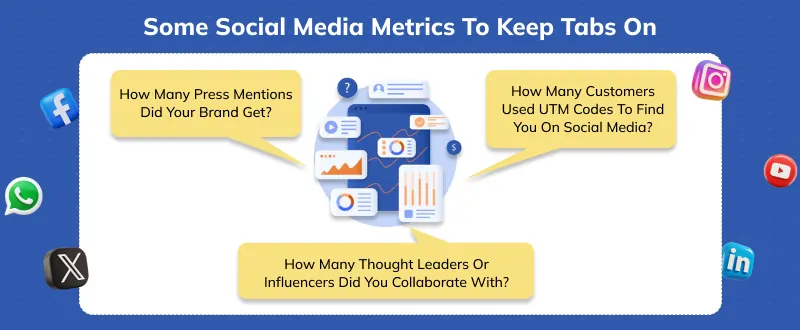
Nothing can be achieved without a goal. Hence, fixing these metrics in the initial step is crucial to solidify your objective. However, remember that while numbers are important, the true impact of social listening on business outcomes can be challenging to measure.
Take a case where an audience learns about your brand name through articles. She also finds you on several social media channels and catches up on influencer videos where they are strongly advocating your brand. Nevertheless, it’s not until two months later that she decides to buy your product and finally converts. This happened because you were top-of-mind and successfully created a strong brand recall.
No denying the fact that social listening played a prominent part. However, directly attributing this delayed action to those efforts is a little tricky. Hence, social media listening aims to gain a more profound outlook of your clientele and be there to address them should they need any assistance.
In the previous section, we discussed how you can track the latest trends on social media using two methods: manually and with the assistance of social media listening tools. Now, let's delve deeper into this topic.
Social listening tools make it easy to watch multiple social media platforms in one spot. They gather brand mentions, posts containing keywords vital to you, and any direct feedback you get through tags or direct messages (DMs).

There are a plethora of social media listening tools that fall under social media management tools. Each has unique features and is suitable for different types of businesses. However, let’s talk about a few of the most used ones.
BuzzSumo, a no-cost social listening provider, simplifies the assessment of your Facebook performance by showcasing the engagements and shares received by different posts. This tool offers Facebook content insights to identify the most effective post types for your audience. It also highlights optimal post length, as well as the best times and days to post.
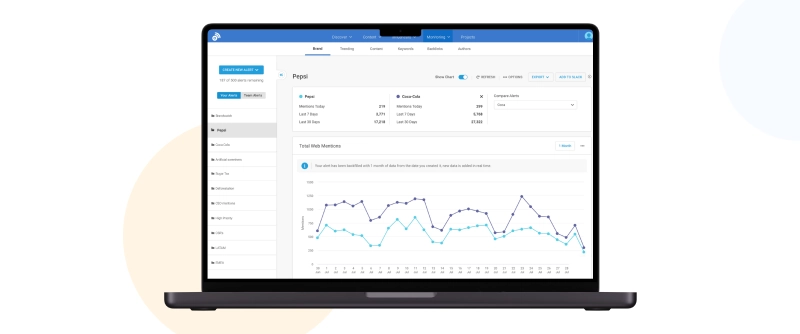 Pricing: Free
Pricing: Free
Buffer offers a seamless experience across all platforms for social media teams. With this social media listening software, you can easily find important interactions, join ongoing conversations, and wow your audience. Utilize the team-shared inbox to post content and promptly respond to comments from one central dashboard.
Buffer's scheduling and publishing features empower you to craft effective social media campaigns. Monitor audience behavior and team performance by keeping tabs on engagement with Buffer's comprehensive reports and analytics tools. Buffer supports major social media platforms like Facebook, Instagram, LinkedIn, Pinterest, and Twitter.
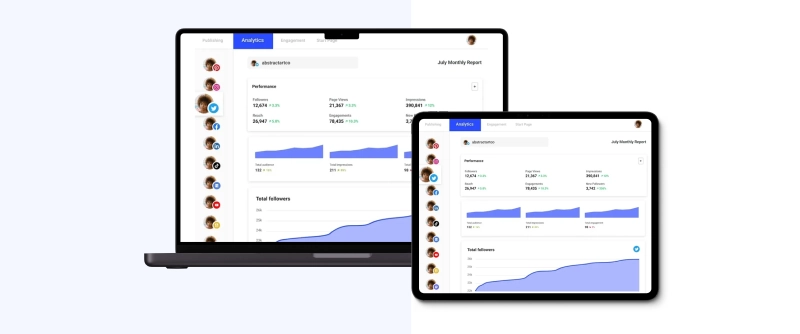
Pricing: Free
HubSpot enables you to track social media interactions, discussions, and followers efficiently. Leveraging contextual data from your contacts' information in the free CRM, this social media listening tool helps you target specific audiences.
Manage all your social media accounts seamlessly with HubSpot's unified solution. Schedule posts weeks in advance, eliminating the need to log into each account individually to upload content. Thanks to HubSpot, you can plan posts across all profiles weeks ahead to save time without compromising your ability to track post performance.
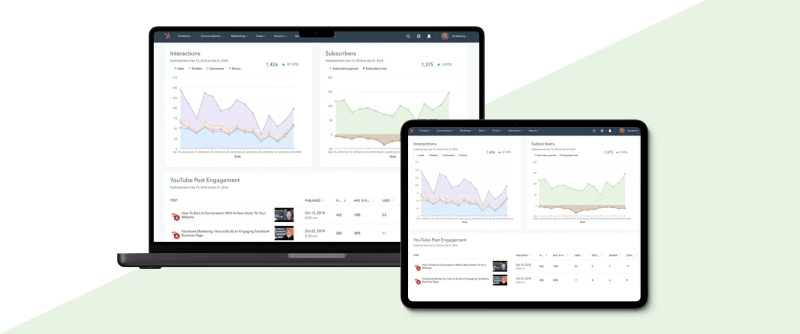
Pricing: $45/month+
Primarily, Keyhole is utilized for brand evaluations on Instagram and Twitter. With the help of this social media listening tool, you can track brand mentions, hashtags, usernames, and other metrics on each and every social media site. Keyhole has a special feature: it can effectively forecast the potential success of hashtags when integrated with AI.
It also provides impressive heat maps displaying global references and engagement, which aids in comprehending your target audience in a better way and ultimately helps in establishing effective communication with them.
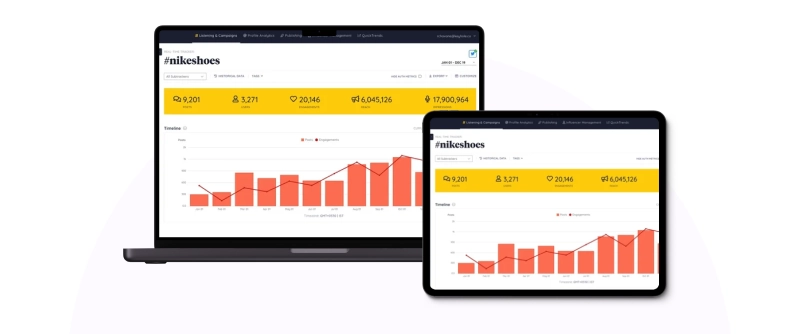
Pricing: $79/month
Hootsuite enables you to create social media streams to track conversations, keywords, mentions, and hashtags. Respond to conversations or mentions directly from your social media dashboard, saving you the hassle of logging in and out of multiple platforms.
It helps you to stay informed about industry trends by monitoring competitors and engaging with the right influencers for your brand and potential brand advocates. Social listening is among the most valued features of Hootsuite by customers.
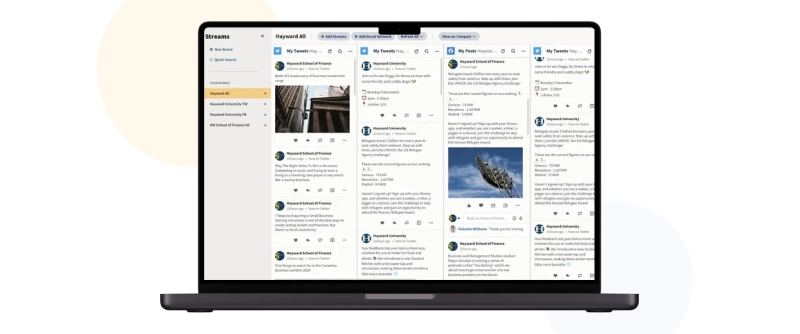
Pricing: $90.43/month (Team). $22.98/month (professional)
As you have seen, there are a multitude of social media listening tools in the market, both paid and unpaid ones. However, finding the right one for your brand is the key to getting the best possible outcomes. Which social listening tool will be the best suited for your business depends on multiple aspects like your requirements, the size of your team, your budget, etc. Free social media monitoring tools have basic analytics best suited for small startups.
However, if you want more features, such as those which can provide deeper insights and more analytics then its best to get an advanced social listening tool with paid plans for your business. Paid tools offer a range of data sources, segmentation options, visualization choices, and user features. You can customize them to suit your team's needs, managing responsibilities and access levels effectively.
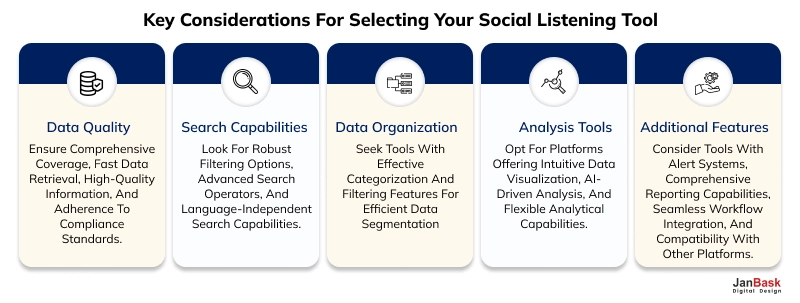
Employing a social listening tool involves four distinct stages:
This, you can say, is the initial step while you are setting up your social listening tool. It’s the basis of your analysis. Once you are done with this step you’ll keep on receiving pertinent information useful for your brand. You can utilize various filters and operators while setting up your search to get filtered data.
After setting up your search and collecting your data, the next thing to do is to segment it. Through segmenting, you’ll be able to turn raw data into meaningful graphs and visuals which would unfold valuable insights. Social listening tools offer a range of features to analyze your data in detail. You can examine consumer sentiment, understand the emotions in their discussions, and view demographic details like location and age.
Now, it's time to dive into the data and extract meaningful insights. These findings will help you address the questions you posed when you first set up your social listening.

By answering these, you'll gain a clearer picture of your brand's performance and customer perceptions.
After the above three steps the final and the most critical step will follow. That is to transfer the information you’ve accumulated into action. These collected insights would facilitate your business decision making process. Advanced social listening tools provide a range of features that help keep stakeholders updated, for example, reporting options or email notifications that would phenomenally simplify your work. This ensures that decision-makers have immediate access to crucial data, enabling them to make smarter, data-driven decisions to enhance the business.
So you learned about the importance of social listening for your brand success, the popular social media listening tools and how to use them. Now it’s time to get your hands dirty and start doing the field work. Here are some tips for you as a bonus:
You can start with perceptual mapping to identify gaps where you can compete with rival brands. This approach helps you connect with your audience by addressing their pain points through your products or services. The best way to understand their challenges is through social platforms, where they often share openly. Here, social media monitoring and listening become crucial, as they provide insights into audience sentiments, psychographics, demographics, behavioral trends, and reach concerning the phenomena you want to learn more about.
Undoubtedly, the best source to learn about an audience’s pain points is the audience themselves. By keeping tabs on social platforms through social listening, you can stay updated on any deficits in your products and services, allowing you to address them promptly and retain high customer satisfaction.
Selecting targeted keywords and topics help in streamlining the process of social listening. The selected keywords should be relevant to your brand so that you receive the pertinent information. However, it’s integral to note that they are likely to update with time as your business strategies also keeps on changing.
For instance, if you look for direct mentions through social media monitoring tools, you might miss out on a chunk since many audiences choose not to mention your brand name directly. In that case, you can monitor by your product name. Social listening tools enable you to monitor your chosen keywords and discover emerging trends and topics within your industry.
Businesses utilize social listening to gauge and respond to customer feedback. These feedback can be both positive and negative. It’s important to actively listen because the data collected through it can be leveraged to enhance your customer service processes or for social media advertising. For instance, if frequent complaints about long wait times arise, whether related to your business or customer service, you can set a goal to reduce response times and resolve issues more swiftly.
A recent survey by Social Intelligence Lab revealed that 89% of respondents rated the quality of data from social listening as high or very high. This shows that listening to customers provides reliable information on necessary actions.
Monitoring recommendations in your industry can help generate valuable leads. By keeping an eye on posts where industry experts suggest products or services, you can identify potential customers and understand their needs. This proactive approach allows you to engage with interested audiences and convert them into loyal clients. For instance: You can respond to “recommendations” posts by providing relevant tips and hacks that audiences would like and cleverly pitch your product if you get pertinent opportunity.
If you are still hesitant about diving into social listening today, here are four pressing reasons that can change your mind! In fact, without social listening you're potentially missing out on a chunk of opportunities, such as, boosted sales, proactive management of negative sentiments, and much more. One small step can significantly impact your brand.
Customers want to feel acknowledged on social media. Research by Sprout Social shows that 46% of consumers believe engaging with your audience on social platforms elevates a brand to best-in-class status online. In fact, responsiveness on social media truly makes a difference. But it goes beyond that. It's about leveraging social listening to create thoughtful responses that offer genuine value. These are the types of interactions that foster brand loyalty and boost customer retention rates with more facebook leads.
Well, everyone. And social listening makes it possible. With social media listening, you can monitor your brand’s performance, closely interact with your audience instantly, and make data-driven decisions to stay ahead. It’s an invaluable tool for understanding and accelerating your brand’s growth dynamically.
Moreover, not every time does your brand garner praise. You can also face negative sentiments or scandals. In that case, you must address it immediately before situations get out of control. By closely examining the issue, you can decode the real source of the problem and decide on the appropriate response for your business.
Social listening can boost leads by identifying potential customers and discussing the needs your products can fulfill. By engaging in these conversations, you can offer solutions and build relationships. This proactive approach attracts new customers and demonstrates your brand's attentiveness and responsiveness, making it more likely they'll choose your services.
Keeping a close eye on your competitors is extremely vital for your business since the competition is cutthroat in the present day market scenario. This makes sustenance more important than success. You can always succeed with a great digital marketing strategy but to retain that success and sustain in the market is the real challenge.
This is why you must keep a close eye on what your competitors are doing, and this can be done seamlessly through social listening. You gain valuable insights into their strategies and market positioning by tracking their online presence, content, and customer interactions. This allows you to stay informed, adapt your own tactics, and seize opportunities to differentiate and outperform them.
Like many brands, the renowned American ice cream brand Ben & Jerry's boosted their social media ads during sunny spells. Evidently, there’s a surge in ice cream sales during scorching summer days. But a snowy New York weekend threw a curveball. They assumed sales would dip, so ad spending stayed flat. Yet, to the brand’s surprise, clicks and sales soared!
They identified the spike once they carefully checked the ad’s performance but had no idea how. Since in cold weather, people would never generally go for a chilled ice cream. But social listening could get you the answer to the “how,” and Ben & Jerry’s is indeed an intelligent brand that did the right thing at the right time.
View this post on Instagram
By analyzing data through meticulous social listening, Ben & Jerry’s discovered a surprising trend: ice cream cravings spiked during bad weather, especially rain. Turns out, folks stuck indoors craved a Netflix & Chill companion – ice cream! This golden nugget of data led to targeted ads and optimized facebook campaigns along with other social media campaigns for rainy days and even a new "Netflix & Chill'd" flavor to the audience’s delight.
Spoiler Alert! @netflix and Ben & Jerry’s just became official! #NetflixandChillld
— Ben & Jerry's (@benandjerrys) January 16, 2020
Find out more at https://t.co/KQTuLu8mue pic.twitter.com/9Xj8HDZKSNSocial listening worked wonders for the brand and skyrocketed sales. Now you know why social media listening is so crucial.
Listening on social media involves tracking and analyzing online conversations about your brand, industry, or related topics. This process helps you understand public sentiment, identify trends, and gather insights to inform your marketing strategies and business decisions. It goes beyond simply monitoring mentions, allowing you to engage with your audience and respond proactively to their needs and concerns.
Social listening is crucial for understanding audience sentiment, identifying trends, and improving engagement. To do it, monitor social media channels for brand mentions, analyze the context, and gather insights to inform your marketing strategies and customer service efforts.
An example of social listening is when a company like Starbucks monitors social media platforms for mentions of their brand and customer feedback. Suppose they notice a trend where customers are frequently requesting a specific type of drink or expressing dissatisfaction with a particular aspect of their service. In that case, Starbucks can use this information to introduce new menu items or improve their service, demonstrating that they are responsive to customer preferences and concerns.
The purposes of social listening include:
Social media monitoring involves tracking brand mentions, hashtags, and keywords to gather data on specific metrics like engagement, reach, and sentiment. It focuses on quantitative data and is more about tracking and reporting on social media activity.
On the other hand, social media listening goes beyond monitoring by analyzing the context and meaning behind conversations. It involves understanding why people are talking about certain topics, identifying trends, and gathering insights to inform business strategies. Social media listening is more about qualitative analysis and understanding the broader social landscape.
When starting with social listening, determine which social networks to focus on by considering these factors:
Audience Presence: Identify where your target audience is most active. Use analytics from your existing social media accounts to see which platforms generate the most engagement.
Industry Relevance: Consider the platforms most relevant to your industry. For example, LinkedIn is crucial for B2B businesses, while Instagram may be better for lifestyle brands.
Competitor Activity: Analyze where your competitors are most active and the platforms they prioritize.
Content-Type: Match the platform to the type of content you create. Visual content performs well on Instagram and Pinterest, while text-based content may be better suited for Twitter or LinkedIn.
Goals: Align your platform choice with your social listening goals, whether it’s brand monitoring, customer service, or market research.
Start with the platforms where these factors overlap, ensuring you maximize the effectiveness of your social listening efforts.
Talking directly with your social followers and prospects builds trust, fosters stronger relationships, and demonstrates that you value their feedback. It also allows you to address concerns, answer questions, and provide personalized experiences, which can enhance customer satisfaction and loyalty.
Social listening works by monitoring online conversations and mentions of your brand, competitors, and relevant topics across various social media platforms. It involves collecting data, analyzing sentiment, identifying trends, and gaining insights. These insights help inform business strategies, improve customer service, and enhance marketing efforts.
So far, we have covered as much as possible in this concise guide on social media listening. You’ve learned how it can be leveraged to skyrocket your brand growth, provided that you use the appropriate social media listening tools that would draw the best outcomes. Its powers are boundless if you do it the right way.
However, it’s always advisable to use advanced social listening tools that are paid since they have a more significant number of features that enable you to interact with and monitor your audience and competitors closely.
When it’s about your brand, you can never take it lightly. You can also assign it to a renowned company like JanBask Digital Design, which offers top-notch social media marketing services to do the heavy lifting for you and provide you with actionable insights.
In this ever-evolving time of growing and shifting customer trends in social media, you need a strong hand to thrive in the market and make a loyal customer base.
Social listening lets you slice through the clutter and track online conversations over time, helping you stay updated on the latest changes and trends. Let’s team up to begin your social listening strategy today, and you'll be amazed at how much you can learn quickly.
Interested in our Social Media Services

Leave a Reply